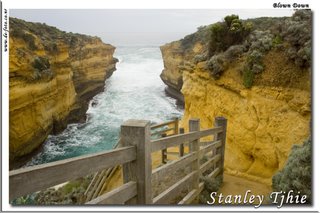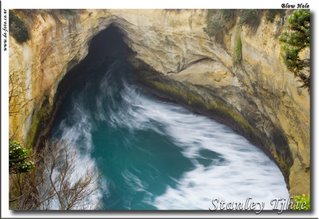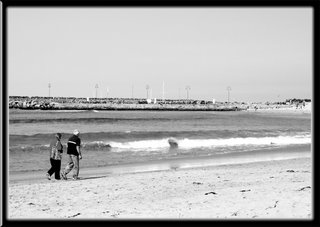This was taken at the Gibson's Steps Beach. My friend asked me to take this picture and added to make it black and white. So there it goes. I'm not very sure why this tree branch is here. Washed up? or could it be that it was growing on this beach last time? No matter what, it seems dead. It is not mangrove tree.
Mangroves (generally) are
trees and
shrubs that grow in saline coastal habitats. Mangal is found in depositional coastal environments where fine sediments, often with high organic content, collect in areas protected from high energy wave action.
- Adaptations to low oxygen
Red mangroves, which can live in the most inundated areas, prop themseles up above the water level with stilt roots, and can then take in air through pores in their bark (lenticels). Black mangroves live on higher ground, and make many pneumatophores (specialised root-like structures which stick up out of the soil like straws for breathing) which are covered in lenticels. These "breathing tubes" typically reach heights of up to 30 centimeters, though some species have ones that reach over 3 meters high. There are four types of pneumatophore - stilt or prop type, snorkel or peg type, knee type and ribbon or plank type. Knee and ribbon types may be combined with buttress roots at the base of the tree. The roots also contain wide aerenchyma to facilitate oxygen transport within the plant.
- Limiting salt intake
Red Mangroves exclude salt by having rather impermeable roots which are highly suberised, acting as an ultra-filtration mechanism to exclude sodium salts from the rest of the plant. Water inside the plant shows that 90%, and in some cases of high salinity, up to 97%, of the salt has been excluded at the roots. Any salt which does accumulate in the shoot is concentrated in old leaves which are then shed, as well as stored away safely in cell vacuoles. White (or Grey) Mangroves can secrete salts directly, they have two salt glands at each leaf base (hence their name - they are covered in white salt crystals).
- Limiting water loss
Because of the limited availability of freshwater in the salty soils of the intertidal zone, mangrove plants have developed ways of limiting the amount of water that they lose through their leaves. They can restrict the opening of their stomata (small pores on their leaf surfaces which exchange carbon dioxide gas and water vapour during photosynthesis) and also have the ability to vary the orientation of their leaves. By orienting their leaves to avoid the harsh midday sun, mangrove plants can reduce evaporation from their leaf surfaces. Anthony Calfo, a noted aquarium author, has observed, anecdotally, that a red mangrove in captivity will not grow unless its leaves are misted with fresh water several times a week, simulating the frequent rainstorms in the tropics.[citation needed]
- Nutrient uptake
The biggest problem that mangroves face is nutrient uptake. Because the soil that mangroves live in is perpetually waterlogged, there is not much free oxygen available. At these low oxygen levels, anaerobic bacteria proceed to liberate nitrogen gas, soluble iron, inorganic phosphates, sulfides, and methane, which help contribute to a mangrove's particularly pungent odor and also make it a hostile environment to most plants. Since the soil is not particularly nutritious, mangroves have adapted by modifying their roots. Prop root systems allow mangroves to take up gasses directly from the atmosphere and various other nutrients, like iron, from the otherwise inhospitable soil. They quite often store gasses directly inside the roots so that they can be processed even when the roots are submerged during high tide.
- Increasing survival of their offspring
In this harsh environment mangroves have evolved a special mechnanism to help their offspring to survive. All mangroves have buoyant seeds that are suited to dispersal in water. Unlike most plants, whose seeds germinate in the soil, many mangrove plants (e.g. Red Mangrove) are viviparous, i.e., their seeds germinate while still attached to the parent tree. Once germinated the seedling grows either within the fruit (e.g. Aegialitis, Acanthus, Avicennia and Aegiceras), or out through the fruit (e.g. Rhizophora, Ceriops, Bruguiera and Nypa) to form what is called a propagule (a seedling ready to go), which can produce its own food via photosynthesis. When the propagule is mature it drops into the water where it can then be transported great distances. Propagules can survive desiccation and remain dormant for weeks, months, or even over a year until they arrive in a suitable environment. Once a propagule is ready to root, it will change its density so that the elongated shape now floats vertically rather than horizontally. In this position, it is more likely to become lodged in the mud and root. If a propagule does not root, it can alter its density so that it floats off again in search of more favorable conditions.
- Mangrove ecosystems
Mangroves support unique ecosystems, especially on their intricate root systems. In areas where roots are permanently submerged, mangroves may be host to a wide variety of organisms, including algae, barnacles, oysters, sponges, and bryozoans, which all require a hard substratum for anchoring while they filter feed. Mangroves are excellent buffers between the violent ocean and the fragile coast, especially during hurricanes, which can bring powerful storm surges onto shores. The massive mangrove root system is quite efficient at dissipating wave energy. This same root system also helps prevent coastal erosion. As tidal water flows through the root system, it is slowed substantially enough so that it deposits its sediment as the tide comes in, and the return flow is kept slow as the tide goes out to prevent resuspension of some of the finer particles. As a result, mangroves can build their own environment. Because of the uniqueness of the mangrove ecosystems, they are frequently the object of conservation programs including national Biodiversity Action Plans.
(courtesy
wikipedia.com)


































